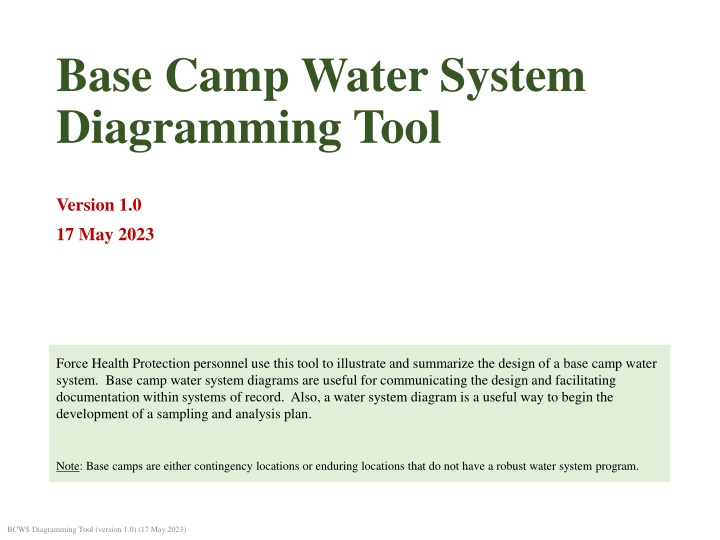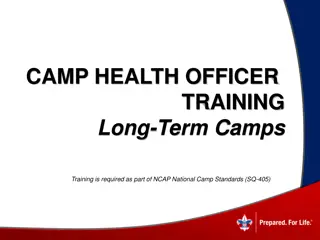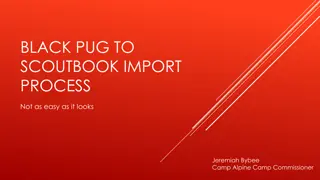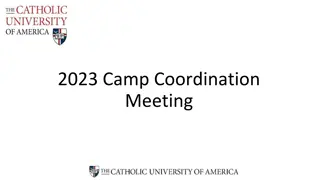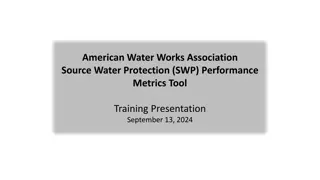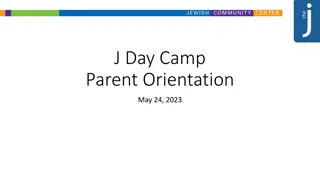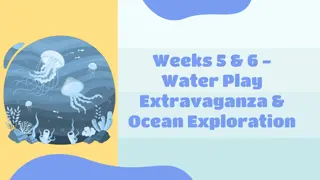Base Camp Water System Diagramming Tool
This tool, designed for Force Health Protection personnel, aids in illustrating and summarizing base camp water system designs. It facilitates communication, documentation, and the development of sampling plans. Users can create water system diagrams using provided icons and modifiers. The tool includes instructions, example diagrams, water quality categories, and common modifiers for system components.
Download Presentation

Please find below an Image/Link to download the presentation.
The content on the website is provided AS IS for your information and personal use only. It may not be sold, licensed, or shared on other websites without obtaining consent from the author.If you encounter any issues during the download, it is possible that the publisher has removed the file from their server.
You are allowed to download the files provided on this website for personal or commercial use, subject to the condition that they are used lawfully. All files are the property of their respective owners.
The content on the website is provided AS IS for your information and personal use only. It may not be sold, licensed, or shared on other websites without obtaining consent from the author.
E N D
Presentation Transcript
Base Camp Water System Diagramming Tool Version 1.0 17 May 2023 Force Health Protection personnel use this tool to illustrate and summarize the design of a base camp water system. Base camp water system diagrams are useful for communicating the design and facilitating documentation within systems of record. Also, a water system diagram is a useful way to begin the development of a sampling and analysis plan. Note: Base camps are either contingency locations or enduring locations that do not have a robust water system program. BCWS Diagramming Tool (version 1.0) (17 May 2023)
Instructions (1) What to Do Develop your water system diagram on Slide 4 by using the icons and common modifiers from Slide 3. If completing a diagram on a computer, then icons can also be found in the area surrounding Slide 4. The diagramming conventions and common modifiers are not mandatory, they can be altered if the user can annotate the diagram to clarify its meaning. More than one water system can be displayed if desired. Add notes to Slide 4 if needed to provide clarity. On Slide 4, the light green table should be completed by the individual drawing the diagram. The dark green table is to be filled in if the diagrammed water system(s) have identification numbers within DOEHRS-IH. (2) Example Diagrams There are example water system diagrams starting on Slide 5. These examples are designed to illustrate diagramming methods and don t necessarily reflect real situations nor provide all possible configurations. However, they should be helpful for how situations can be illustrated. BCWS Diagramming Tool (version 1.0) (17 May 2023)
Water Quality Categories: Icons and Modifiers Disinfected Untreated Treated Do not delete or modify any of the icons and modifiers on this slide. To use them, simply copy and paste each one you need into Slide 4. Then, on Slide 4, update them as necessary for your site-specific diagram. For your site-specific diagram, replace each icon s MOD with a specific modifier. If a common modifier does not apply to a situation, then use OTH (Other) or generate your own modifier label and explain in your diagram. Distribution System Water Source* Point of Use (POU)* Water Container* Treatment Mobile Delivery*** MOD MOD MOD MOD MOD *** No MOD needed for the dashed line Multiple Units* Treatment system Untreated water source Untreated water container MOD MOD DIS Pipe / Hose MOD Multiple Units* MOD MOD Disinfection only Disinfected fresh water source Common Modifiers (MOD) MFWPS Military Field Water Purification System COTS Commercial/Non-fielded small purification system CTR Contractor-Built System WTP Fixed Water Treatment Plant DIS Disinfection only (a DOEHRS component if mechanical dosing) Disinfected fresh water container Common Modifiers (MOD) A Alloy ACP Asbestos Cement Pipe C Canvas CI Cast Iron CN Copper/Nickel GS Galvanized Steel PVC Polyvinyl Chloride UNK - Unknown MOD MOD MOD Multiple Units* MOD Treated water source Common Modifiers (MOD) AS Aid Station/ Medical Facility BK Barracks DFAC Dining Facility L Laundry LT Latrine OPS Operational building R Recreation SH Shower WP Water Point WR - Washrack Common Modifiers (MOD) GW Groundwater MW Municipal Water SW Surface Water Treated water container Note: Provide brief system description Common Modifiers (MOD) BUF Water Trailer (Buffalo) CAM Water Trailer (Camel) COM Commercial Tank FB Fabric Tank/ Bladder HIP Water Tank Rack (Hippo)** TR Commercial Tank Truck/ Trailer Note: MW Municipal Water should be annotated as untreated per TB MED 577 (Section 2-3). Water from host nation municipal drinking water systems is non-potable until shown to meet appropriate MFWS, and/or is approved by PM personnel for drinking. Sampling Point Field Test with AWT Sample Field Test Only ** Within DOEHRS-IH, a Water Tank Rack (Hippo) is called a Water Tank Truck MILSPEC * Source, Container, POU icons can be multiples BCWS Diagramming Tool (version 1.0) (17 May 2023)
Base Camp Water System Diagram DOEHRS-IH Water System (WS) Information WS ID WS Name Completion Date Country: Base Camp: Preparer s Name, Email, Unit: Disinfected fresh water source Water Quality: Untreated Disinfected Treated BCWS Diagramming Tool (version 1.0) (17 May 2023)
Example Diagrams BCWS Diagramming Tool (version 1.0) (17 May 2023)
Example Water System Diagram #1 The diagram quickly communicates the key aspects of the design and uses of the water system. This diagram has two systems. It includes all water system components and points of use; and depicts how water moves from the source to all points of use. The water system component icons (triangles, diamonds, circles, and boxes) should reflect whether the water at that point in the system is treated water, disinfected fresh water, or untreated water. Example sampling points are shown here; note that these will be needed when creating a sampling and analysis plan (SAP). Tap1 Patriot Tank #1 Spigot A SH Shower Trailer #1 COM Water System 1 GW Tap1 Patriot Well #2 PVC TR L PVC Tank Truck SN: 1234GY Force Provider Laundry #1 Veggie Sink PVC TWPS Water System 2 DFAC PAT TPWS SN: 0YT763 Patriot DFAC Water Quality: Effluent Untreated Note about sampling points Adding sampling points is optional. When creating your water system diagram, do not add sampling points until the diagram is accurate. Then, add sampling points only if desired to communicate planned or actual sampling activities. Specific sampling point selection guidance is currently being developed. Disinfected Treated BCWS Diagramming Tool (version 1.0) (17 May 2023)
Example Water System Diagram #2 BK Base Camp Boundary ROWPU GW DFAC Alpha Well #1 ROWPU Water System 1 AS BUF Water Buffalo Note: Adding base camp and water system boundaries to a diagram is optional. They have been added in this series of examples in order to facilitate discussion. Water System 2 SH-LT COM 3 units Disinfected fresh water container Water Quality: Commentary While there is one diagram here, for the purposes of DOEHRS-IH documentation there are two (2) water systems at the base camp. Both systems share the same source of water, a ground water well. Note that both water systems can be drawn together as shown here, and that in this example all elements of both water systems are physically located within the boundaries of the base camp. Also, note within water system 1, how to show a water container being used directly next to a point of use. Untreated Disinfected Treated BCWS Diagramming Tool (version 1.0) (17 May 2023)
Example Water System Diagram #3 BK ROWPU Base Camp Boundary Water System ROWPU SH-LT COM SW 2 units Treated water container Meade River DFAC ROWPU ROWPU Water Quality: Untreated Commentary In this example, there is one water system and the water source for the system is located outside the boundary of the base camp. Note that how the water gets from the river to the two ROWPU units is via a pipe or hose, since the connecting lines are solid. Disinfected Treated BCWS Diagramming Tool (version 1.0) (17 May 2023)
Example Water System Diagram #4 Base Camp B Base Camp A DFAC ROWPU ROWPU MW BK SH-LT Host Nation Municipal Water System 4 units Water System B Water System A SW River Water Quality: Commentary Here, there are two (2) nearby base camps and each camp has its own water system. However, both water systems share the same water source, a local host nation municipal water system, which derives from a local river. Note: For DOEHRS purposes, each base camp could have its own separate diagram. They are combined here for illustration and discussion. Untreated Disinfected Treated BCWS Diagramming Tool (version 1.0) (17 May 2023)
Example Water System Diagram #5 Host Nation s Military Base DFAC U.S. Base Camp TR MW SW Lake Zulu Host Military s Water Treatment System Disinfected fresh water container BK U.S. Base Camp Water System Water Quality: Commentary This illustrates a case where our base camp sits within a host nation s military base. Note that the host nation s water treatment system is rendered using a triangle with an X even if they treat their water. This is because U.S. field water doctrine states that, in general, any water source must be U.S. treated before we use it ourselves no matter how that source water is treated. The exception to this is when source water is approved by the local US medical authority or is provided and treated by a NATO ally and meets standards in STANAG 2136 (refer to TB MED 577). Untreated Disinfected Treated BCWS Diagramming Tool (version 1.0) (17 May 2023)
Example Water System Diagram #6 Base Camp A Base Camp B SW Untreated water source BK TR ROWPU MW 2 buildings w/ showers Untreated water source Treatment System Base Camp B Water System SH 5 trailers Base Camp A Water System Water Quality: Untreated Commentary Here is a situation where one base camp receives its source water from another nearby base camp via a Tank Truck, which transports water from one camp to the other. Note that the water system for Base Camp B includes the Base Camp A treatment system and the source water from that system, because all water system diagrams must show the origin of the water prior to U.S. military treatment. Disinfected Treated BCWS Diagramming Tool (version 1.0) (17 May 2023)
Example Water System Diagram #7 OPS 10 buildings Base Camp Boundary Water System 3 LSA ROWPU 4 buildings ROWPU OPS MW Host Nation 6 buildings (operations) Water System 1 Water System 2 Water Quality: Untreated Disinfected Commentary Yes, three water systems can be shown on one diagram, this one shows three (3). All three source their water from a host nation municipal water system. Treated BCWS Diagramming Tool (version 1.0) (17 May 2023)
Example Water System Diagram #8 (Team House) Team House Aspen 1800BC KITCH COM MW Team House Kitchen Treatment system Untreated (unknown treatment) municipal water source SH Team House Shower L Team House Latrine Water Quality: Untreated Commentary The diagramming tool can also be used for team houses. In this example, within a team house there are multiple points of use, in the kitchen and the bathroom, and the water container is also part of the team house. Disinfected Treated BCWS Diagramming Tool (version 1.0) (17 May 2023)
Example Water System Diagram #9 (Team House) Team House KITCH TR COM MW Team House Kitchen Untreated (unknown treatment) municipal water source Water Tank Tank Truck BATH Bathroom (Latrine, Shower, Utility sink) Water Quality: Untreated Commentary In this team house example, a tank truck delivers host nation municipal water to a commercial water tank that is part of a team house. Within the house there are distribution pipes from the water tank to the kitchen and the bathroom. Within the bathroom, there are multiple points of use, a latrine, a shower, and a utility sink Disinfected Treated BCWS Diagramming Tool (version 1.0) (17 May 2023)
